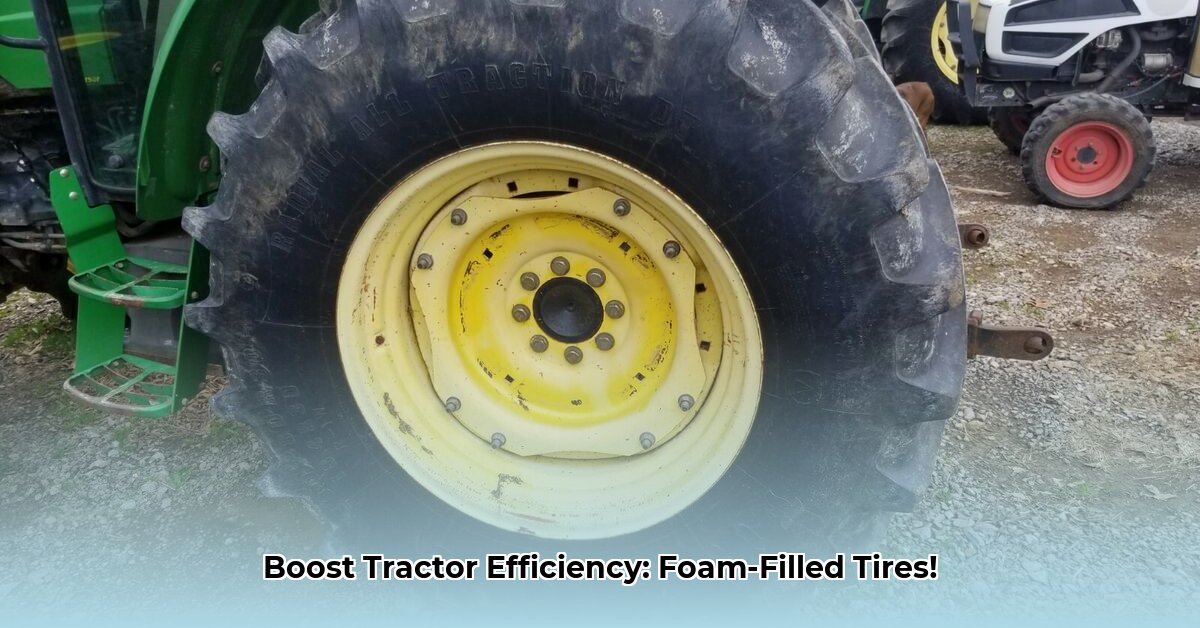
Foam-Filled Tractor Tires: A Comprehensive Analysis
Considering foam-filled tires for your tractor? This article provides a data-driven assessment of their benefits and drawbacks, guiding you towards an informed decision. We'll analyze the cost-benefit implications, explore installation and maintenance, and help you determine if this upgrade aligns with your farming operation's specific needs. For help determining the right tire size, use this tire size calculator.
The Advantages of Foam-Filled Tractor Tires: Increased Productivity and Reduced Downtime
The primary benefit is undeniably the reduction in flat tires. This translates directly to increased productivity. Less downtime means more time spent in the field, leading to higher yields and improved profitability. A significant advantage for farmers who frequently encounter challenging terrain such as rocky fields or muddy conditions where punctures are common. Many farmers also report improved traction, particularly valuable for heavier equipment like harvesters and balers, requiring maximum grip. Reduced downtime minimizes labor expenses associated with tire repair or replacement. Increased operational efficiency contributes to a significant boost in net profitability.
But are these advantages significant enough to outweigh the drawbacks? That depends on your individual circumstances. How much does unplanned downtime cost your operation?
The Disadvantages: Weighing the Costs and Trade-offs
The most significant drawback is the high initial cost. Foam-filled tires represent a substantial investment, significantly higher than air-filled alternatives. This initial expense must be factored into any cost-benefit analysis. Additionally, the increased weight of foam-filled tires puts additional stress on components like rims, wheel hubs, and bearings. This leads to increased maintenance costs and potentially shorter lifespans for these parts. Finally, while eliminating the jarring experience of a flat tire, foam-filled tires generally deliver a less comfortable ride, potentially leading to increased operator fatigue during long working days. Operator comfort is indeed an often overlooked factor and must be considered when evaluating long-term productivity.
A Practical Decision-Making Framework: Cost-Benefit Analysis for Your Farm
Determining the suitability of foam-filled tires requires a personalized cost-benefit analysis, encompassing these key factors:
Terrain Analysis: The nature of your farmland directly impacts the frequency of tire punctures. Rough terrains with rocks, debris, and uneven surfaces inherently increase the likelihood of flats, making foam-filled tires a more attractive option.
Equipment Assessment: Heavier equipment is more susceptible to tire damage and benefits more from the improved stability and traction provided by foam-filled tires. Lighter equipment might not necessitate the additional expense.
Downtime Cost Quantification: Calculate the monetary value of downtime caused by flat tires. This encompasses lost productivity, labor costs, and potential crop damage. High downtime costs often justify the upfront investment in foam-filled tires. What's the hourly cost of your operation being stalled?
Maintenance and Repair Cost Projections: Compare current tire repair expenses with projected maintenance costs for foam-filled tires (including potential increased wear on rims and hubs). A thorough financial forecast is critical before making a decision. How much do you anticipate saving in repair costs?
The following table summarizes the comparison:
| Feature | Air-Filled Tires | Foam-Filled Tires |
|---|---|---|
| Initial Cost | Lower | Significantly Higher |
| Ongoing Repair Costs | Higher (flats, punctures) | Lower (fewer flats) |
| Downtime Costs | Higher | Lower |
| Operator Comfort | Generally Higher | Generally Lower |
| Potential Soil Compaction | Moderate | Potentially Higher |
A Step-by-Step Guide to Implementing Foam-Filled Tires
Comprehensive Needs Assessment: Evaluate your farm's operational characteristics, including terrain, equipment usage, and current tire maintenance expenses.
Total Cost Calculation: Develop a detailed financial model projecting the total lifecycle costs (covering initial investment, maintenance, and potential downtime) for both air-filled and foam-filled options over a reasonable timeframe (e.g., 5-7 years).
Pilot Program Implementation: Before a complete transition, consider a pilot program, installing foam-filled tires on one or two tractors. This provides valuable real-world data relevant to your specific operations.
Continuous Performance Monitoring and Adjustment: Track tire performance, maintenance expenses, and operational efficiency. This allows for course correction and optimization of your investment.
Calculating Total Lifecycle Cost: A Detailed Approach
The total lifecycle cost (TLC) should be carefully calculated to accurately assess the true economic impact. The initial purchase price is often misleading as it doesn't represent the full cost of ownership. TLC computation should include:
Initial Foam Filling Cost: The cost per pound of foam varies regionally and depends on tire size.
Air-Filled Tire Repair/Replacement Costs: Project these costs by accounting for the frequency of punctures in your specific environment.
Foam-Filled Tire Maintenance Costs: Include the increased maintenance due to potential wear and tear on rims, hubs, and bearings.
Tire Lifespan Estimation: Estimate the lifespan for both options. Foam-filled tires may wear out faster on hard surfaces.
Total Cost Calculation: Sum the above costs over the projected lifespan of the tires to obtain the total lifecycle cost for each option.
The Final Verdict: A Data-Driven Decision
Foam-filled tractor tires provide significant advantages regarding reduced downtime and potentially improved traction in adverse conditions. However, the substantially higher upfront cost and increased maintenance requirements necessitate a thorough cost-benefit analysis. The optimal choice depends entirely on the specific characteristics of your farm operation. A comprehensive evaluation based on your unique circumstances is crucial for making a financially sound decision. Remember, maximizing the long-term profitability of your farm requires a strategic approach to all investments.